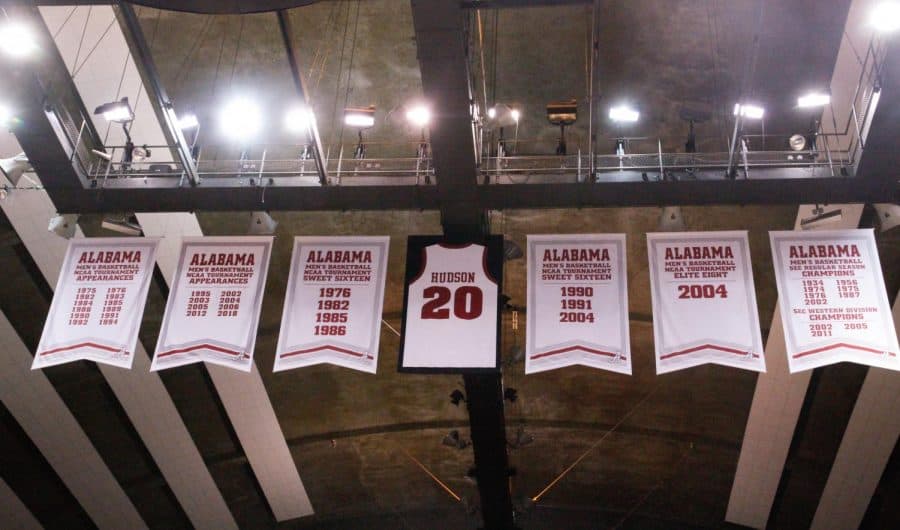Cemented in history: Hudson immortalized with jersey retirement
February 17, 2020
In the weeks leading up to his departure, Wendell Hudson heard his mother, Mildred, hum and sing as she went about the house cooking or cleaning. The sound of his mother making little melodies wasn’t unfamiliar to Hudson. It was something she had done often. But she had never sung or hummed quite so much, and to Wendell, that was one of the small signs that she wasn’t comfortable with what was about to happen.
Weeks later, it did happen: Hudson walked onto the University of Alabama campus as the first African American scholarship athlete in the school’s history. Prior to Hudson, the only African American athletes on campus were walk-ons. By signing with the University’s basketball team, Hudson shattered barriers and opened the gates for other African American athletes.
More than 50 years later, Hudson once again walked on campus to do something that no other student athlete had done before – have his jersey retired. During halftime of Alabama’s 88-82 victory over LSU on Saturday afternoon, a black curtain fell down from the rafters of Coleman Coliseum, unveiling a white No. 20 jersey with “Hudson” written in crimson on the back. It was a historic moment for one of Alabama’s most important historical figures. Along with retiring his jersey, Alabama will honor Hudson by having all spring sports teams don a black “WH” patch on their jerseys.
When he decided to come to Alabama as a lanky, 6-foot-6 teenager, Hudson wasn’t thinking about his place in history. He was just looking for a place to play basketball. Legendary Alabama coach C.M. Newton gave him a chance to do that at The University of Alabama.
“It’s an unbelievable feeling to think that an 18-year-old person that would be like them right now did not really have a clue what he was really doing when he came here from a historical standpoint, but [I] kind of felt like it would be an opportunity to play and do some things,” Hudson said to media members before the LSU game.
Even after Hudson arrived on campus, he didn’t feel like the trailblazing figure that many, including documentarian Keith Dunnavant, have called him. Dunnavant detailed Hudson’s historical significance in his 2013 film “Three Days at Foster.”
“Wendell is a pioneering figure – not only in sports at The University of Alabama, but in the culture of the state of Alabama,” Dunnavant said. “The step that he took when he was signed in 1969, it’s hard to imagine how difficult it was from the vantage point of the 21st century. He was the only black face in Bryant Hall for a year.”
Hudson may have been one of the few African American athletes on campus, but he never felt out of place at the University. Unlike most stories of integration, Hudson’s tale doesn’t include terrible acts of violence or overt racism. There was an ugly incident during an away game at Ole Miss in which insults were hurled from angry fans, but Hudson said that he wasn’t mistreated on Alabama’s campus.
“My story is not the necessarily typical story of integrating the athletic department and being the first black athlete, because I had fun,” Hudson said. “It was enjoyable. It was fun. It was a good story.”
Hudson’s teammates, who were all white at the time he signed, embraced him and helped make his transition to the Capstone as smooth as possible, according to Wimp Sanderson, an assistant coach on Newton’s staff at the time Hudson was recruited.
“One of the keys to recruiting players is your players,” Sanderson said. “Players recruit players … When [Hudson] came in to visit, all the players that we had were Caucasian at that time, and he felt comfortable around them.”
Soon Hudson wasn’t the only African American player on Alabama’s roster. By his senior season, he was one of several black players on the team, joined by all-time great Alabama players like Leon Douglas and Charles Cleveland. African Americans were finally awarded scholarships on other sports teams as well, including the football team. In 1970, Wilbur Jackson became the first black scholarship football player when he was given an offer from Paul “Bear” Bryant.
Half a century has passed since Hudson opened the door, but today’s Crimson Tide athletes are still thankful for what he did.
“[Hudson] paved the way for guys like me,” sophomore point guard Kira Lewis Jr. said. “Without him, maybe I’m probably not here, maybe I am. More than likely I’m not here, so with him doing what he did, that’s a big accomplishment. Hats off to him. He was a great player. People are going to look up to him for what he did.”
Hudson’s lasting influence is one of the primary reasons that athletic director Greg Byrne decided to make his jersey the first to be retired in the school’s history. Alabama has seen countless spectacular athletes, from Pro Football Hall of Famer Bart Starr to seven-time NBA champion Robert Horry, but none have been immortalized in the way that Hudson was on Saturday. That’s not an indictment on the accomplishment of other Crimson Tide greats; it’s simply a testament to what Hudson achieved.
When praised for being a trailblazer, Hudson is likely to brush it off with a joke. But history will continue to show the impact he had. And if anyone happens to forget, they simply have to look toward the rafters in Coleman Coliseum, where the No. 20 hangs – the first, and only, of its kind.





















